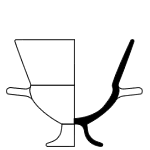Calyx
In classical archeology, a special variant of ancient ceramics is called kalyx (English chalice ) . This is a chalice-shaped drinking vessel , the ancient variant of the chalice .
The shape was produced in many places throughout almost the entire period of antiquity and even the Bronze Age . The shapes of the dishes were sometimes very different and subject to changes and developments.
The Attic kalyx is reminiscent of an intermediate form between the kylix with foot and the footless lakaina and looks like a small variant of the chalice crater . The substructure is designed like a bowl, the body is supported by a short, wide base of the bowl, which stands on a fairly broad base. The handles are roughly level with the edge of the bowl. However, a broad lip was placed on top of this, so that this drinkware is reminiscent of a goblet. This is why the kalyx is also called a goblet . The shape was made quite rarely and rarely decorated by vase painters.
literature
- John Boardman : Black-Figure Vases from Athens. A manual (= cultural history of the ancient world . Volume 1). von Zabern, Mainz 1977, ISBN 3-8053-0233-9 , p. 21.
Web links
- Various kalykes in the Beazley Archives

